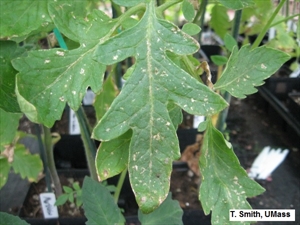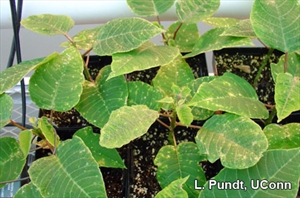- Worldwide distribution. On more than 250 plants in 65 families; these include: soft fruit (plums, peaches, strawberries, grapes); flowers (Gladiolus, Impatiens, Gerbera, Chrysanthemum, poinsettia); vegetables (cucumber, tomato, capsicum, cabbages, beans), and wild flowers. An important pest.
- Eggs laid in flowers or leaves; nymphs and adults cause distortions, spots and silvering, and spread viruses (e.g., Tomato spotted wilt virus).
- Spread by short flights, and by the plant trade.
- Cultural control: check seedlings in nurseries – if necessary, use thrips-grade screen; 10 m grass strips around nurseries; avoid planting new crops near old; weed; use yellow or blue sticky traps to monitor thrips; rogue plants with virus; collect and burn trash after harvest; crop rotation.
- Chemical control: soap, white or horticultural oils, neem or spinosad; note, thrips has resistance to many synthetic pesticides.
Pacific Pests, Pathogens and Weeds - Online edition
Pacific Pests, Pathogens, Weeds & Pesticides
Western flower thrips (183)
Western flower thrips
Frankliniella occidentalis
AUTHOR Grahame Jackson
Information from CABI (2020) Frankliniella occidentallis (western flower thrips). Invasive Species Compendium. (https://www.cabi.org/isc/datasheet/24426); and Western flower thrips. Plant Health Australia. (https://www.planthealthaustralia.com.au/pests/western-flower-thrips/); and from DPIRD (2016) Chemical control of western flower thrips. Agriculture and Food. Government of western Australia. (https://www.agric.wa.gov.au/fruit/chemical-control-western-flower-thrips). Photo 1 T Smith, University of Massachusetts.Bugwood.org. Photo 2 L Pundt, University of Connecticut. Photo 3 William M Brown Jt., Bugwood.org. Photo 4 Whitney Cranshaw, Colorado State University, Bugwood.org. Photo 5 Jack T Reed, Mississippi State University. Bugwood.org. Diagram Life cycle western flower thrips. University of Massachusetts.
Produced with support from the Australian Centre for International Agricultural Research under project PC/2010/090: Strengthening integrated crop management research in the Pacific Islands in support of sustainable intensification of high-value crop production, implemented by the University of Queensland and the Secretariat of the Pacific Community.









